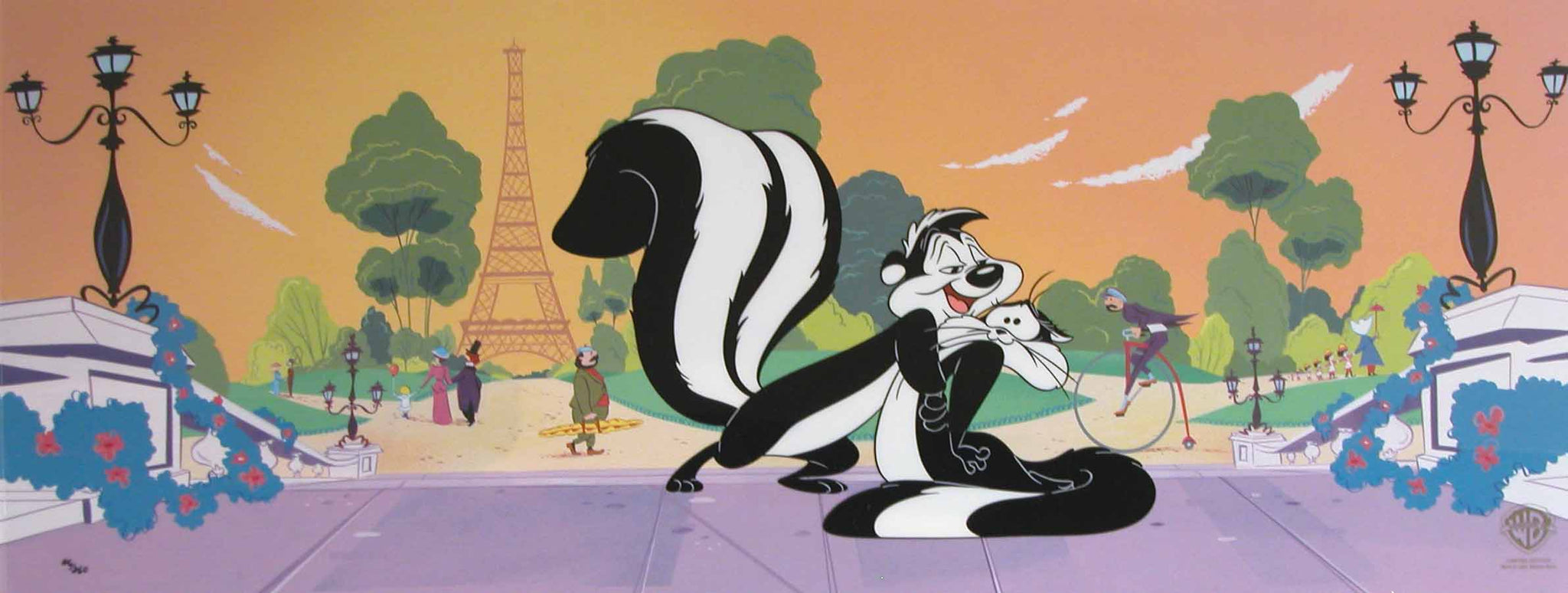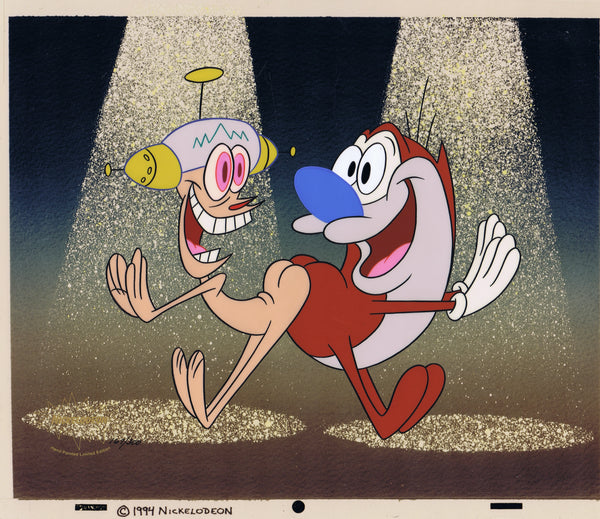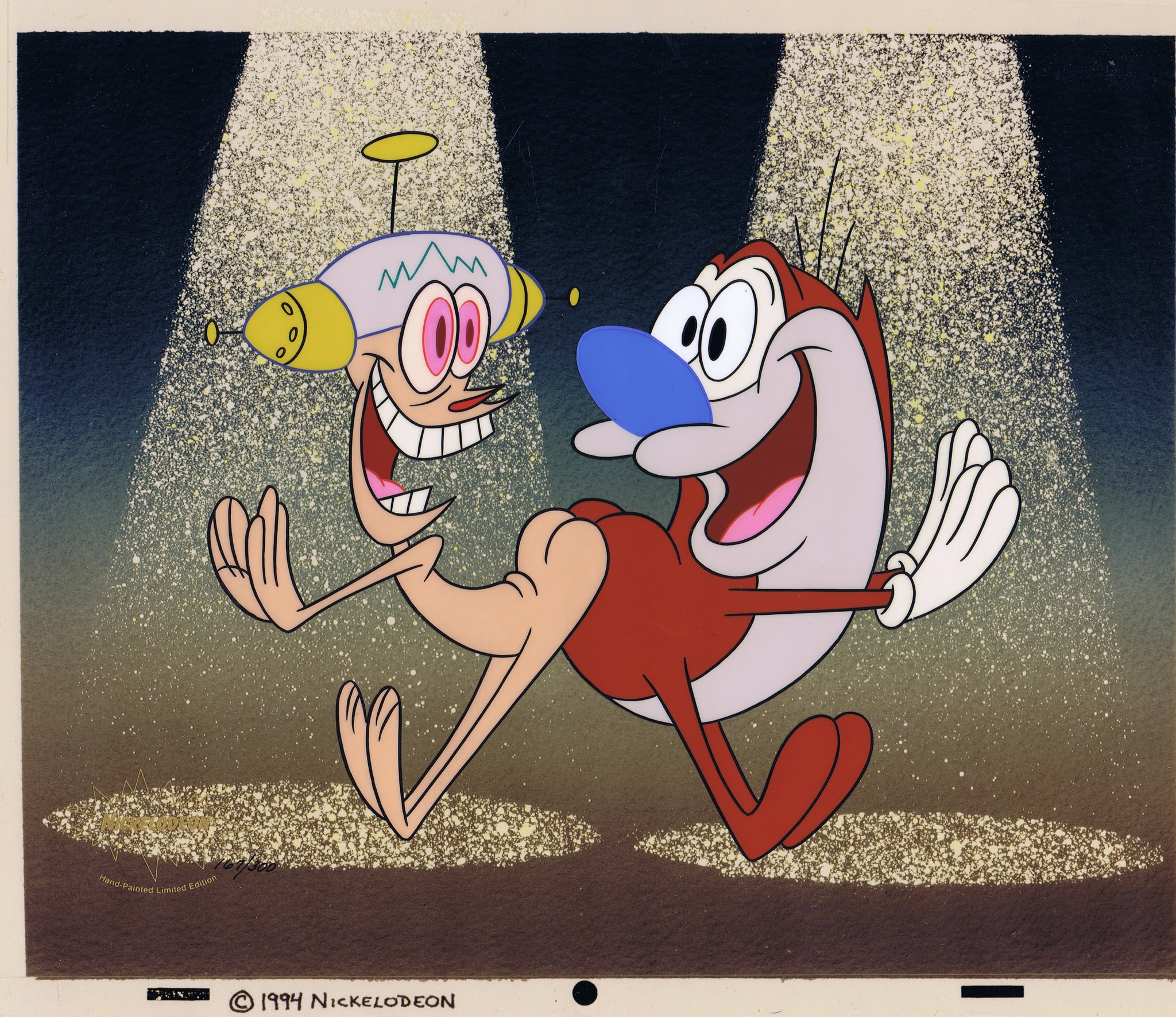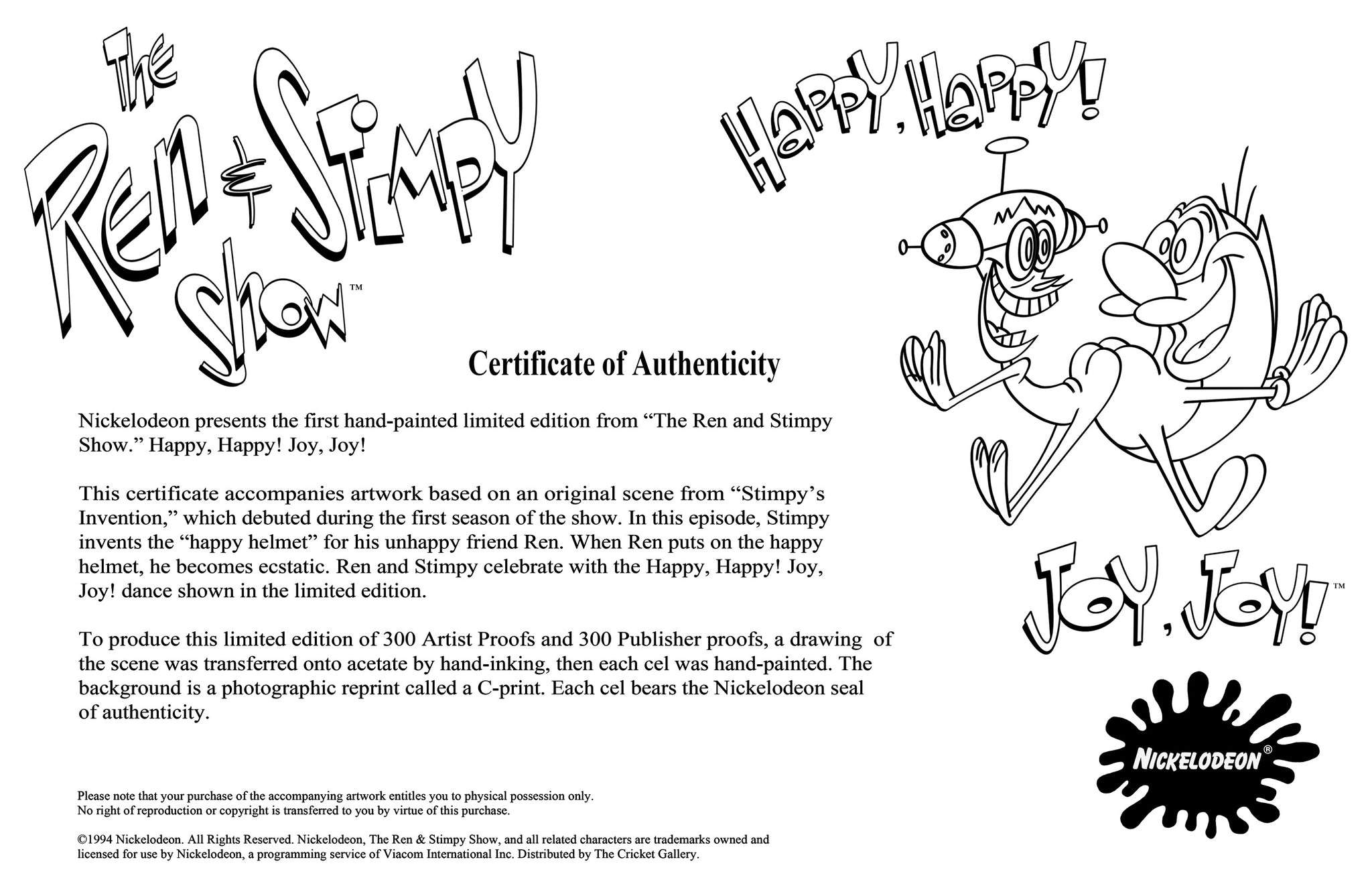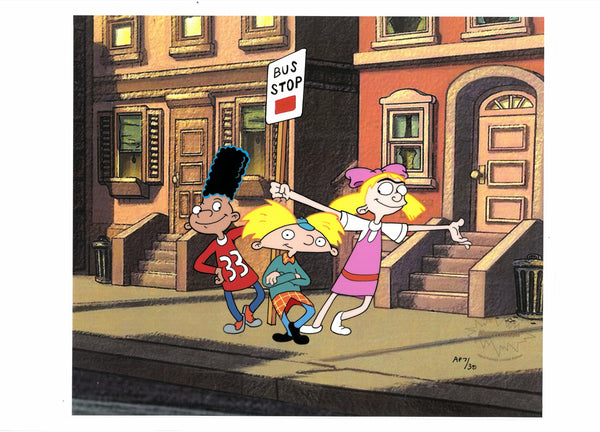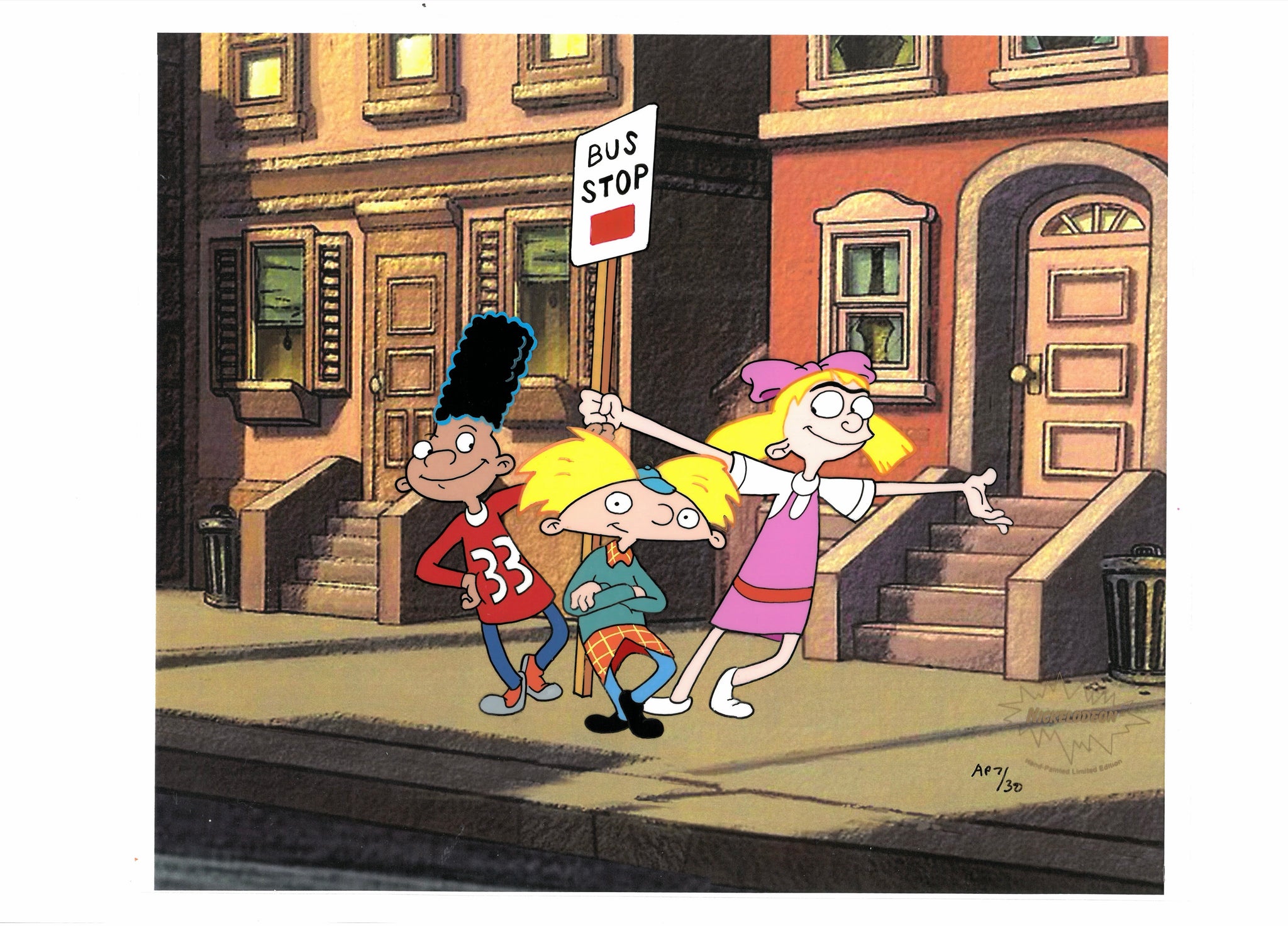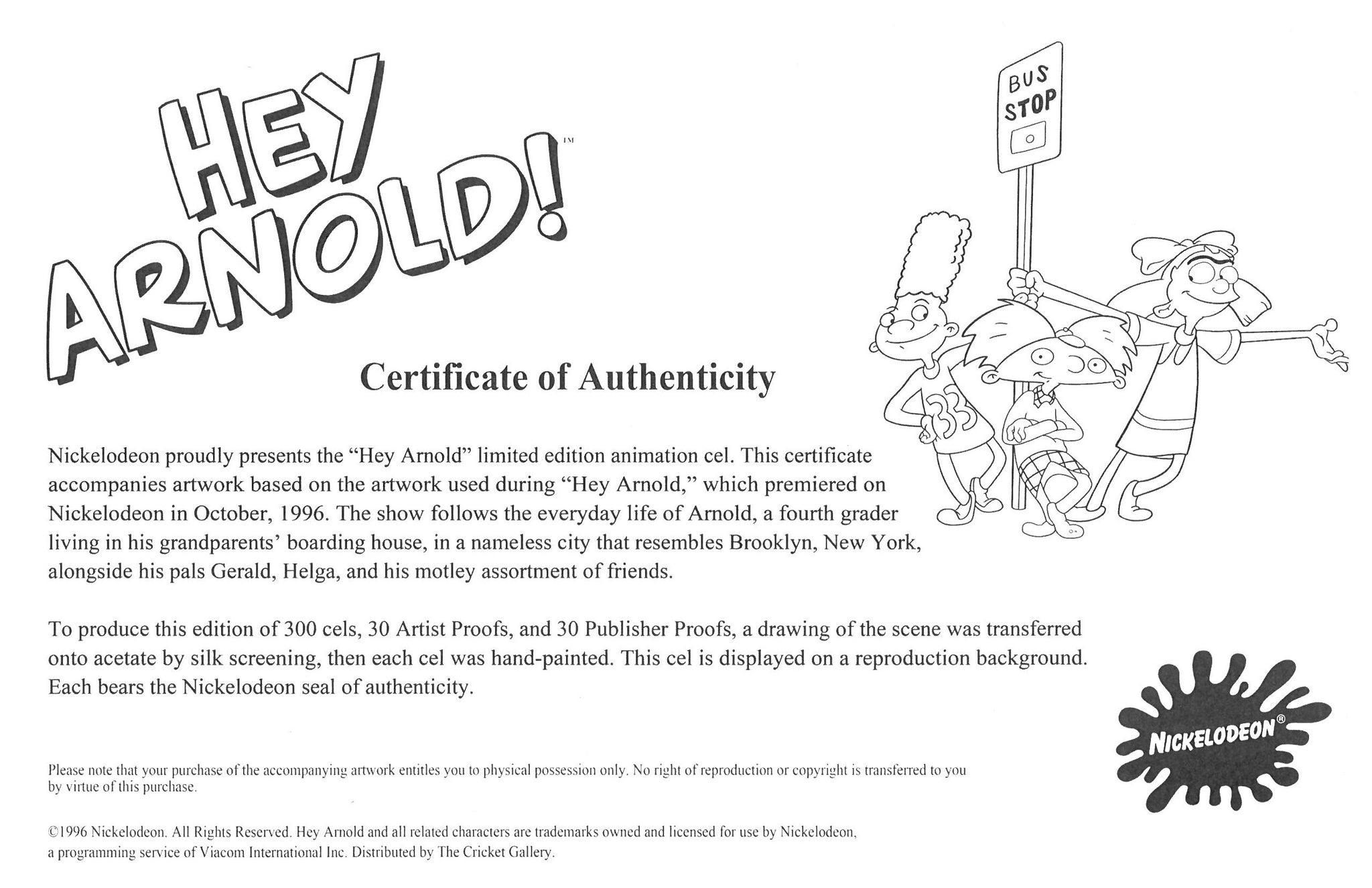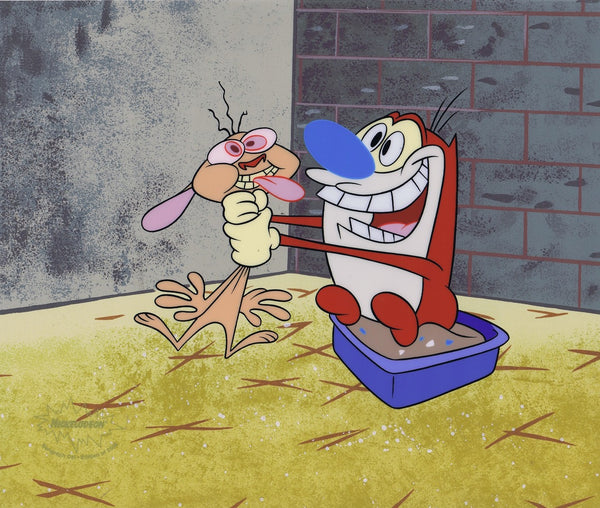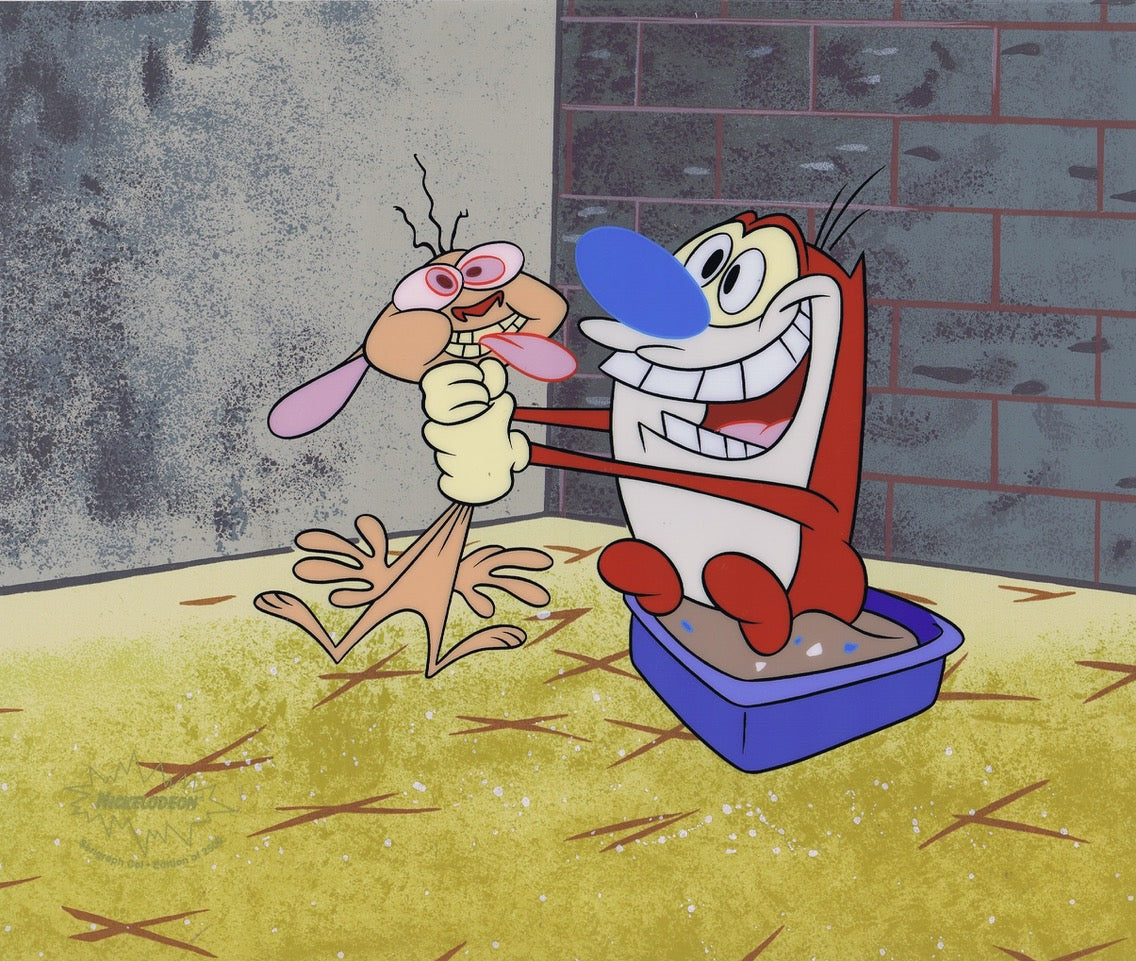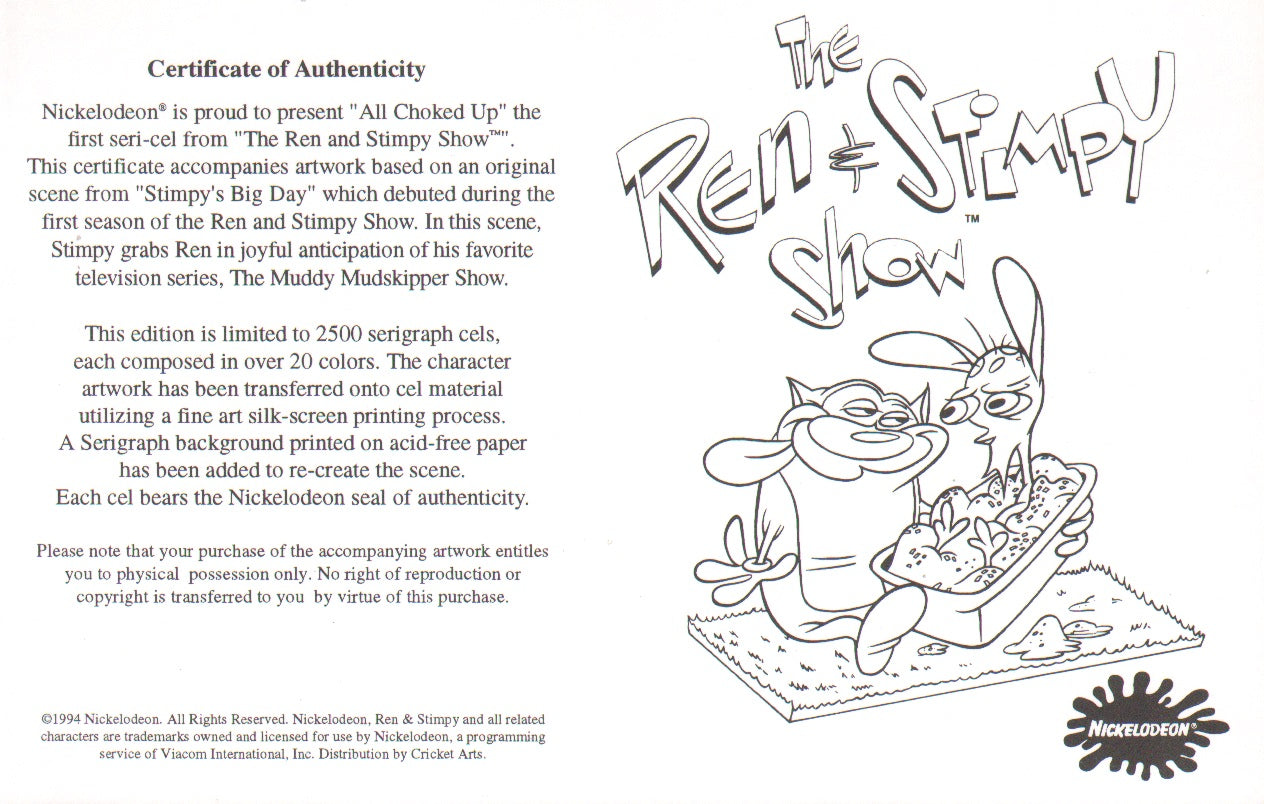USE SHOP PAY FOR 4 EQUAL NO INTEREST PAYMENTS
+GLOSSARY
View the full glossary here for a better understanding of the art.
"Amour Parisienne" Pepé Le Pew Limited Edition Pan Cel 0f 250 (Warner Brothers, 2000)
$940.00
“Try To Run – Try to Flee – But You’ll Never Escape Me – on the streets Of Paris!” Pepe Le Pew chases down his paramour Penelope on the streets of Paris, as usual unable to comprendez the concept of rejection. Designed in homage to the Pepe Le Pew cartoons of Chuck Jones, and the high-concept style of Looney Tunes background artist Maurice Noble in particular, this hand painted limited edition cel captures the essence of the era of animation which brought us stars such as Pepe and Penelope.
This Limited Edition Cel began with a drawing by famed animator Dan Haskett, Laurie Dindis created the master inking which was then silk-screened with the Warner Bros. Seal onto an acetate sheet (or “cel”). Each cel was the hand-painted on the reverse side in the style of classic cel animation. The background layout drawing by Steve Lewis was rendered to perfection by artist Alan Bodner, and was reproduced on acid-free paper using the digital Giclee process. The edition number was hand-inked on each cel in a special edition size of only 250 pieces. This cel was issued in 2000. Unframed.
Chuck Jones:
As one of the chief animators and directors during the golden age of Warner Bros. animation, Chuck Jones forged a legacy as being the creator of some of the funniest and most beautifully designed cartoons ever produced by the Hollywood studio system. Alongside Tex Avery, Bob Clampett and Friz Freleng, Jones spearheaded the innovative and wildly popular cartoons that populated the Looney Tunes and Merrie Melodies worlds. With such iconic characters as Bugs Bunny, Daffy Duck, Porky Pig and Elmer Fudd, the cartoons were irreverent comedies that broke new ground and rankled future generations, which often sought to censor re-airings on television for violence and racial stereotypes. For his part, Jones was responsible for some of the most famous cartoons, directing such popular ones as "Hare-Raising Hare" (1946), "Duck Dodgers in the 24½th Century" (1953), "Baby Buggy Bunny" (1954) and "What's Opera, Doc?" (1957), widely considered to be the greatest cartoon ever made. He also was the creator of several characters, including Pepe Le Pew, Wile E. Coyote and the Roadrunner. After being let go from Warner Bros. in the early 1960s, Jones revived the "Tom and Jerry" cartoons before serving as an independent producer on a number of made-for-television movies. Both unpretentious and self-conscious, Jones' animation mastery during the 1940s and 1950s was unparalleled, and cemented his place as an innovative contrarian.
Born on Sept. 21, 1912 in Spokane, WA, Jones was raised by his father, Charles, an unsuccessful businessman who authored the cookbook Fifty Ways to Serve Avocados, and his mother, Mabel. When he was a child, Jones moved with his family to Los Angeles, where he began appearing as an extra in silent films shot near his home. A high school dropout, Jones enrolled in the Chouinard Art Institute in Pasadena - later known as the California Institute of the Arts - when he was 15 years old, and graduated without feeling secure about his drawing abilities. He found work in a commercial art studio but found himself unsuited to the job, and left to take a job as a cel washer at the Ub Iwerks Studio, which at the time was producing "Flip the Frog" cartoons. He progressively moved up the ranks, becoming a cel-painter, cel-inker and assistant animator before being fired by Iwerks. Jones worked briefly as an assistant animator for producers Charles Mintz and Walter Lantz before being rehired by the Iwerks studio, only to be fired again by Iwerks secretary Dorothy Webster, whom he married in 1936.
Jones found a job as a seaman on a large schooner, only to see the ship be destroyed by fire. He subsequently began working as puppeteer and portrait painter in a bohemian part of Los Angeles, before the future Mrs. Jones obtained him a job as an assistant animator with Leon Schlesinger Productions, the animation unit at Warner Bros., in 1933. The animation producing team of Hugh Harman and Rudolf Ising had recently departed and Schlesinger was building his own unit. Jones was promoted to animator in 1934 and worked on several cartoons helmed by Friz Freleng and others before being assigned with Clampett to Tex Avery's unit at Termite Terrace, the nickname for the bungalow on the Warner lot where the animators worked. With this astonishing assemblage of talent, which first collaborated on the epochal "Golddiggers of '49" (1936), Avery's first cartoon for Warner Bros., a new era in cartoon history had begun. Jones and Bob Clampett were briefly loaned out to the faltering Iwerks studio to work as co-directors on two entries in the Gabby Goat series. Soon after their return, Clampett was promoted to director and Jones became his animator. Jones graduated to directing in 1938, when Frank Tashlin left Warner Bros.
Jones' early directorial efforts owed a strong debt to Walt Disney in both style and subject matter; the cartoons typically featured a small, quiet character in a large, forbidding environment. His first was "The Night Watchman" (1938), which told the story of a kitten who fills in for his ailing father as the regular night watchman of the house. His first original character of note was Sniffles, a talkative little mouse clad in a porkpie hat and scarf, who debuted in "Naughty but Mice" (1939) and appeared in several more cartoons before being retired in 1947. Other early highlights included an odd series of five cartoons starring Inki, a little stereotyped "African" in his topknot. These dreamy dialogue-less adventures tended to concern Inki's tumultuous efforts to hunt a lion, as showcased in "Little Lion Hunter" (1939), "Inki and the Lion" (1941) and "Inki and the Mynah Bird" (1943). While some of Jones' early films were charming, others were cloying, but they often tended to be beautifully crafted. By his own admission, his efforts lacked a sense of humor, and it would take him some time to display the sassy irreverence and skillful comic timing that would eventually characterize his best work.
Working with the characters that would make him an animation legend, Jones directed the second and third appearances of the prototypical Bugs Bunny in "Prest-o Change-o" (1939) and "Elmer's Candid Camera" (1940), which starred Merrie Melodies star Elmer Fudd (voiced by Mel Blanc). Tex Avery would finally crystallize the rabbit's personality later in "A Wild Hare" (1940), and once he had a firm grip on the character, Jones became one of the best directors of the character, as clearly evidenced by the time of the classic "Case of the Missing Hare" (1942). Jones was the driving force behind a number of other popular Bugs Bunny cartoons, including "Hare-Raising Hare" (1946), in which Bugs is pitted against a Peter Lorre-like mad scientist and a large, orange-haired, sneaker-clad monster; "Baby Buggy Bunny" (1954), in which the foundling Bugs takes into his care is actually the notorious gangster Babyface Finster; and "Bully for Bugs" (1953) in which he accidentally burrows into a Spanish bullring - uttering the classic line "I knew I shoulda taken that left turn at Albuquerque!" - and tangles with an angry bull.
Under Jones's direction, another popular Merrie Melodies character, Daffy Duck, was portrayed as a cowardly self-preservationist continually undone by his own greed or selfishness. Jones' trilogy of cartoons starring Bugs Bunny, Daffy Duck and Elmer Fudd - "Rabbit Fire" (1951), "Rabbit Seasoning" (1952) and "Duck! Rabbit! Duck!" (1953) - were masterfully subtle and imaginative examples of character animation as the three very different personalities interacted in a variety of situations involving hunting and whether it was truly rabbit season or duck season. Jones also derived much comic mileage from placing Daffy in wildly incongruous settings such as in "The Scarlet Pumpernickel" (1950), "Duck Dodgers in the 24½th Century" (1953) and "Robin Hood Daffy" (1958). This tendency was amplified to a nearly cosmic degree in "Duck Amuck" (1953), a classic example of reflexivity in cinema, in which Daffy was explicitly presented as an animated figure tormented by a mostly off-screen animator.
Jones won Warner Bros. an Oscar for Best Animated Short Subject with "For Scent-imental Reasons" (1949), which starred one of his most popular creations, the amorous French skunk Pepe Le Pew. The formula for these cartoons was fairly rigid: a female cat somehow has a streak of paint drawn down the middle of her back and Pepe mistakes her for another skunk. Immediately smitten with love, he pursues her while being totally oblivious of her revulsion to his odor. Jones created an even more minimalist situation for his most successful creation, the Road Runner and Wile E. Coyote series. The formula was totally inflexible: each cartoon was set in the desert; the Coyote always chased the Road Runner, whom he never caught; the Coyote was always done in by his own efforts; and the characters never spoke. At their best, they had an absurdist, existential quality, as on display in "Hook, Line and Stinker" (1958), "Hip Hip-Hurry!" (1959), and "Hopalong Casualty" (1960). In later episodes, the Coyote sought outside help to further his goal of capturing the Roadrunner, with the hapless canine generally ordering elaborate, but dysfunctional devices from the ACME Corporation which invariably betrayed his naive faith in them.
In addition to working with an impressive stable of continuing characters, Jones also excelled at one-shot cartoons. The most celebrated example might well have been "One Froggy Evening" (1955), an unsettling allegory about a singing frog. Retrospectively christened Michigan J. Frog, the character became the symbol of Warner Brothers' WB Network in the mid-1990s. Meanwhile, many fans, historians and fellow animators believed that Jones achieved his masterpiece with "What's Opera, Doc?" (1957) which miraculously condensed Wagner's 14-hour "Der Ring des Nibelungun" into a classic six-minute cartoon starring Bugs Bunny and Elmer Fudd. The extraordinarily lavish spoof of opera required 106 shots whereas a typical cartoon used around 60. Also a wicked parody of Disney's "Fantasia" (1940), background artist Maurice Noble's monumental designs and melodramatically theatrical color schemes were unlike anything previously seen in a Warner Brothers cartoon. "What's Opera, Doc?" wittily analyzed the long-running battle between Elmer and Bugs, and recast it in larger-than-life terms complete with original songs and a hilariously animated ballet. In 1992, the film was justly selected for inclusion in the Library of Congress' National Film Registry, while it was voted by 1,000 animators as being the greatest cartoon of all time.
SHIPPING: We strive to ship within 1 day of cleared payment. We treat every item we sell with the extra care it deserves. Cels, drawings and sculptures are packed so that they will stay safe during every step of the shipping process. Due to the packing materials we use our shipping prices may seem higher than other sellers who might put a cel into a tube or thin envelope. We are not making a profit on shipping. Only the cost we pay is passed along to you. Please let us know if you need to receive your purchase by a particular date. Email with any questions or concerns.
INTERNATIONAL BUYERS TAKE NOTE: Import duties, taxes and charges are not included in the item price or shipping charges. These charges are the buyer's responsibility. Please check with your country's customs office to determine what these additional costs will be prior to bidding/buying. These charges are normally collected by the delivering freight (shipping) company or when you pick the item up; do not confuse them for additional shipping charges. We do not mark merchandise values below value or mark items as "gifts" - US and International government regulations prohibit such behavior. All Customs Forms will reflect the ACTUAL price that the bidder paid for the merchandise. [For example, I will not claim on the customs form that the bidder paid $10.00, if the bidder actually paid $30.00] Please do not ask us to do so.
Note: All items are shipped FOB. This means that the sellers (The Cricket Gallery’s) liability for the item ends upon our delivery of the package to the shipping agent. It is the Buyers responsibility to insure the package against loss, damages or other unforeseen circumstances. Should the Buyer want The Cricket Gallery, to provide insurance we will do so at the Buyer’s request in writing and upon the payment of an additional charge for such insurance. Buyers outside the USA are likewise responsible for insurance as well as all taxes, tariffs, customers and other charges imposed for international shipments.
.
Related Items
Ren and Stimpy Happy Happy Joy Joy Limited Edition Artists Proof
$495.00
"Happy Happy Joy Joy" Hand Painted Limited Edition AP Edition of 30 (you will be receiving a different number than shown in the photo)Limited Edition...
View full product detailsHey Arnold Limited Edition Artists Proof Cel Nickelodeon 1990s
$425.00
Hey Arnold Very Rare Artists Proof Limited Edition of 300 with 30 Artists Proofs Nickelodeon Productions Cel Features: Arnold, Gerald & Helga Hand Painted Cel on a...
View full product detailsRen & Stimpy Limited Edition Sericel Cel 1990's All Choked Up
$175.00
This is a Limited Edition Sericel of Nickelodeon REN AND STIMPY titled “ALL CHOKED UP”. This fantastic animation is from a scene of the...
View full product details
